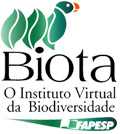 |
BIODIVERSIDADE DE INTERAÇÕES ENTRE VERTEBRADOS FRUGÍVOROS E PLANTAS DA MATA ATLÂNTICA DO SUDESTE DO BRASIL Auxílio FAPESP 98/05090-6 |
 |
BIODIVERSIDADE DE INTERAÇÕES ENTRE VERTEBRADOS FRUGÍVOROS E PLANTAS DA MATA ATLÂNTICA DO SUDESTE DO BRASIL Auxílio FAPESP 98/05090-6 |
SUMMARY
Biodiversity of interactions between frugivorous vertebrates and plants in the Atlantic Forest of southeastern Brazil.
Mutualistic interactions between flowering plants and frugivorous vertebrates came to a climax in the tropical forests, where many species of birds and mammals contribute successfully to the dispersal of seeds of different plant families. Especially in the neotropics, frugivores comprise a significant but fragile component of the total vertebrate biomass, being strongly affected by habitat fragmentation or deterioration, bringing unknown consequences for the plants they disperse.
Traditionally, biodiversity studies rely mainly on accounts of animal or plant taxa found in a given area, but little attention is given to the trophic structure linking these taxa, which ultimately determines the maintenance of spatial heterogeneity and taxonomical diversity in tropical forests. The general purpose of this project is to assess and monitor the biodiversity of interactions between seed plants and frugivorous vertebrates, through their qualitative and quantitative aspects, and look for the major ecological and evolutionary trends and patterns that regulate the mutualistic association within these communities. This approach is integrated to the objectives of the special research program "Conservation and sustainable use of the biodiversity in the State of São Paulo - BIOTASP". The biome chosen to carry out this study is the Atlantic Forest of southeastern Brazil, at the Intervales State Park (ISP)
The main purpose will be achieved by:
a) Recording the fruit diet of frugivorous vertebrates year round;
b) Describing morphological, phenological, and chemical traits of the fruits eaten by frugivores;
c) Describing morphological and behavioral traits of frugivores, as well as the variation in fruit consumption in both time and space.
d) Elaborating matrixes of interactions between plants and animals in the different communities to be studied, and examining the ecological and evolutionary patterns that define their structure and organization.
e) Determining the keystone species of plant and animals in the communities studied, which are expected to participate in a significant number of interactions, and verifying the use of frugivores as indicator-species in studies of biodiversity and conservation.
f) Distinguishing different levels of biodiversity between communities through the comparison of indexes that express the interactions’ richness and complexity, like "connectance" and "dependence".
g) Elaboration of theoretical models for connectance between natural communities, making testable predictions over the relations between phylogeny, biodiversity, complexity, and stability.
This project will be carried out in four years. The study sites will be three areas in the altitudinal gradient occuring at the ISP. Each area will be visited at least on a monthly basis by the different work groups during two consecutive years (two of them simultaneously). Botanical data will include collection and identification of zoochorous plants, their habitat characteristics, descriptions and measurements of fruits and seeds, phenological records, chemical analyses of nutritive and secondary compounds in fruits. Zoological data will include field observation of frugivores feeding behavior, collecting of fecal samples with mist-nets (birds and bats) and along trails (other mammals), descriptions and measurements of morphological traits associated with fruit-eating behavior (taken in field or museum). As birds and bats are the most important seed carriers in tropical systems and their standardized sampling techniques allow multiple comparisons within and between communities, both groups will be used as a key-component in the overall analysis of the frugivores community in the study areas.
The matrixes of frugivory interactions will allow correlations of morphometrical (fruit and seed mass, number of seeds per fruit, gape width, body mass, etc) and chemichal/physiological (pattern of seed deposition in feces, nutrient and energetic content of fruits) variables from both fruits and animals. The comparison of the values obtained from the matrixes for interacting pairs of species, feeding guilds or the whole frugivores community, along with the estimation of connectance between communities and its relation to morphological, ecological and phylogenetic determinants, will allow to evaluate how diverse and functionally integrated a community is, providing basic information for its management and conservation. All data sets will be integrated to geographical information systems (GIS).